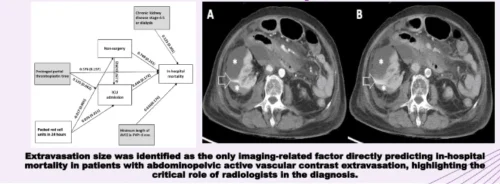Active vascular contrast extravasation (AVCE) is a critical finding on computed tomography (CT) that often necessitates emergent treatment. First reported in 1989, AVCE manifests as a focal collection of contrast material adjacent to injured organs with high-attenuated hemoperitoneum. The rapid, noninvasive nature of CT makes it invaluable for diagnosing and localising AVCE, significantly aiding treatment selection and procedural planning. Nonsurgical interventions such as transarterial embolisation (TAE) and endoscopy have become prominent in managing abdominopelvic bleeding. Understanding the prognostic factors associated with AVCE is essential for improving patient outcomes. A recent article published in Insights into Imaging explores the clinical and CT-based factors associated with in-hospital mortality in adults with AVCE on abdominopelvic CT, providing insights that may inform acute management decisions and reduce morbidity and mortality.
Study Design and Patient Selection
A retrospective study was conducted at a 2200-bed academic hospital, approved by the Institutional Review Board. The study included adult patients (age ≥18 years) who had undergone abdominopelvic CT between January 2019 and May 2022, revealing AVCE. Out of 575 initial reports, 272 CT examinations with AVCE were included after re-review by an experienced emergency radiologist. The patient clinical information, laboratory results, treatment, and outcome data were collected from the hospital's electronic database. CT examinations were obtained using one of four multidetector scanners, with parameters ensuring detailed imaging. Image reinterpretation and space assignment for AVCE were conducted by two radiologists, with disagreements resolved by a third expert.
The study included 272 adult patients with AVCE, with a mean age of 60.2 years. Most AVCE cases were nontraumatic, with the gastrointestinal tract being the most common site. The in-hospital mortality rate was 25.7%, with higher mortality observed in older female patients with underlying diseases, low blood pressures, and abnormal coagulation parameters. Multivariable analysis identified five factors independently associated with in-hospital mortality: nonsurgery, chronic kidney disease (CKD) stage 4-5 or dialysis, prolonged partial thromboplastin time (PTT), minimum AVCE length in portovenous phase ≥8mm, and higher rate of packed red cell (PRC) transfusion.
Clinical Data Abstraction and Imaging Analysis
Clinical information was abstracted from electronic medical records by two physicians who were aware of the research objectives but blinded to specific AVCE locations. Data included demographics, physical examinations, laboratory results, diagnoses, treatments, CT, and angiographic findings. CT scans were independently reviewed for AVCE characteristics by two radiologists specialising in emergency and body imaging. Measurements included the size and attenuation of AVCE, recorded as area, perimeter, minimal and maximal diameters, and mean attenuation in Hounsfield units (HU). These parameters were calculated as percentages of changes between different CT phases (arterial phase, portovenous phase, delayed phase).
Statistical Analysis and Path Analysis
Statistical analysis involved comparing categorical and continuous data to investigate factors associated with in-hospital mortality. Univariable and multivariable binary logistic regression analyses identified factors linked to mortality. Path analysis, a component of structural equation modelling (SEM), explored the complex interplay between identified variables and their effects on mortality. This approach modelled direct and indirect relationships within a set of variables, providing a robust framework for elucidating the underlying mechanisms governing mortality in AVCE patients. The final model was selected based on its fit indices and explanatory power.
Chronic Kidney Disease and Dialysis
Severe CKD or dialysis was a significant predictor of mortality in AVCE patients. Uremic bleeding, often seen in CKD patients, is linked to platelet dysfunction and anaemia, increasing bleeding risks. Dialysis patients face continuous platelet activation, further complicating bleeding scenarios. Recognising these underlying conditions is crucial for managing AVCE patients effectively.
Prolonged Partial Thromboplastin Time
Prolonged PTT, indicating coagulation abnormalities, was critical in active bleeding scenarios. This parameter signifies underlying conditions like liver disease and consumptive coagulopathy, which are associated with increased morbidity and mortality. Prolonged PTT reflects the severity of the bleeding condition and the body’s response to ongoing blood loss.
AVCE Size and Heterogeneity
CT findings revealed that the minimum AVCE length in the portovenous phase was a significant predictor of in-hospital mortality. Larger AVCEs were associated with higher mortality, underscoring the importance of detailed CT evaluation. Heterogeneity in AVCE, measured by standard deviation values and changes between CT phases, suggested a higher bleeding rate and increased mortality risk.
Non-Surgical Treatment and PRC Transfusion
While advancements in non-surgical interventions have improved bleeding control, the study found that surgical treatment yielded better outcomes regarding in-hospital mortality. Surgery remains crucial for managing traumatic bleeding cases, with procedures like damage-control surgery playing vital roles. PRC transfusion had an indirect influence on mortality, with higher rates linked to increased mortality in ICU settings. This complex interaction highlights the need for careful consideration of transfusion strategies.
This study identified several clinical and CT-based factors influencing in-hospital mortality in patients with AVCE on abdominopelvic CT. Factors such as severe CKD, prolonged PTT, larger AVCE size, and PRC transfusion rates significantly impacted mortality. Understanding these factors aids in acute management decisions, potentially reducing morbidity and mortality. Radiologists play a crucial role in detecting and evaluating AVCE features, providing essential information for treatment planning. Further research, including prospective studies and randomized controlled trials, is needed to validate these findings and improve patient outcomes. By elucidating the pathways to death in AVCE patients, healthcare providers can better anticipate and manage complications, optimising patient care.
Source & Image Credit: Insights into Imaging






